Juicy cucumbers "Adam" with a delicate sweetish taste from Dutch breeders
The early maturing Dutch hybrid Adam f1 is suitable for individual cultivation in compost pits and barrels without forming bushes, on a trellis with minimal pinching skills from a gardener. The culture is unpretentious to care for due to small leaves that do not take on the main food and do not shade the fruits from the sun.
In the article, we will reveal the secrets of growing a hybrid, forming bushes, protecting against downy mildew and insects in protected and unprotected ground.
The content of the article
Description and characteristics of the hybrid
The breeders of the Dutch company Bejo Zaden were engaged in the breeding of the cucumber Adam f1.
Early ripe parthenocarpic suitable for cultivation in protected and unprotected soil... The bushes are indeterminate, with an unlimited growth point, medium-growing.
Pictured is a hybrid cucumber Adam f1.
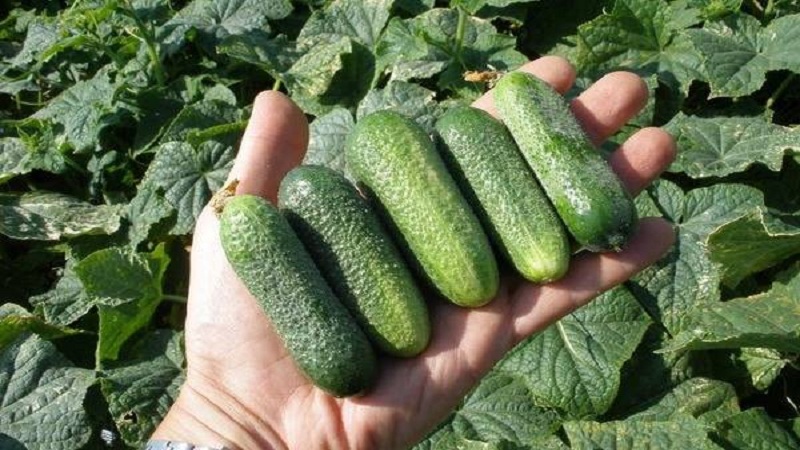
Distinctive features are presented in the table.
| Indicators | Characteristic |
| Ripening period | 45-55 days |
| Pollination type | Parthenocarpic |
| Weight | 90-95 g |
| Length | 9-10 cm |
| The form | Cylindrical |
| Coloration | Green or dark green with short light stripes and mild mottling |
| Leaves | Small in size, dark green |
| Pulp | Dense, crispy |
| Taste | Excellent, sweetish, without bitterness |
| Skin | Thin with many small tubercles and white pubescence |
| Appointment | Universal |
| Yield | 8-10 kg / m² |
| Sustainability | Olive spot, powdery mildew, cucumber mosaic virus |
| Transportability | Average |
Composition, calorie content and benefits
 Calorie content cucumbers - 14 kcal per 100 g.
Calorie content cucumbers - 14 kcal per 100 g.
Chemical composition product:
- vitamins A, B1, B2, B4, B5, B6, B9, C, E, H, K, PP and beta-carotene;
- minerals: potassium, calcium, silicon, magnesium, sodium, phosphorus, iron, iodine, copper, selenium, fluorine, zinc.
Regular consumption of cucumbers has a positive effect on the body:
- normalizes water-salt balance;
- accelerates metabolism;
- dilates blood vessels;
- normalizes blood pressure;
- breaks down cholesterol plaques;
- dissolves stones and sand in the kidneys;
- normalizes the work of the pancreas;
- improves blood counts.
Hybrid agricultural technology
Cucumbers Adam grown through direct sowing and seedlingsfollowing the scheme:
- sowing for seedlings is carried out a month before the intended planting in a permanent place;
- direct sowing and transfer of seedlings to open ground is carried out when the threat of night frosts disappears;
- seeds are sown in the greenhouse at a soil temperature of + 15 ° C, air temperature - + 22 ° C.
Direct sowing in the ground
Hybrid seeds do not need disinfection and soakingif they already have a colored shell. This indicates that the material has been processed in production. Seeds without a shell are disinfected in a weak solution of potassium permanganate and soaked in preparations that accelerate germination - "Epin" or "Zircon".
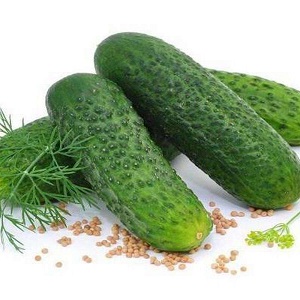 Direct sowing is carried out in the last days of May in the southern regions and in the first days of June in regions with a cooler climate. When choosing a place, they are guided by the southern side of the site. Soil temperature should be at least +15 ° С.
Direct sowing is carried out in the last days of May in the southern regions and in the first days of June in regions with a cooler climate. When choosing a place, they are guided by the southern side of the site. Soil temperature should be at least +15 ° С.
The best predecessors of cucumbers - cabbage, onions, carrots, garlic, legumes. It is advisable to avoid the beds on which zucchini, pumpkin, melon, watermelon, squash grew.
To protect plantings in the open field from drafts, curtain plants (corn, sunflower) are sown nearby.
The plot is prepared in advance - in the fall they dig up and bring in a bucket of humus per 1 m². In autumn, the soil is loosened and fertilized with chicken droppings mixed with ash or ready-made dressing "Gumi-Omi", "Zdraven".
Seeds are planted to a depth of 3 cm every 20 cm, watered with warm water and covered with mulch (hay, straw, sawdust).
About other varieties and hybrids of cucumber:
Early ripe hybrid of cucumbers "Hector" for open ground
Sowing seedlings
Sowing work begins at the end of April... The soil is prepared from peat, humus, sawdust in a ratio of 2: 2: 1. The mixture is thoroughly mixed in a bucket, add 1 tbsp. l. superphosphate and 200 g of ash. For disinfection it is poured with a strong solution of potassium permanganate or treated with "Fitosporin".
Wet soil is laid out in 0.5 liter containers. Seeds, if necessary, are disinfected and soaked, then embedded in peat glasses to a depth of 2 cm. The future seedlings are covered with a film and left in a dark place at a temperature of +25 ° C. The seeds will hatch in 3-5 days.
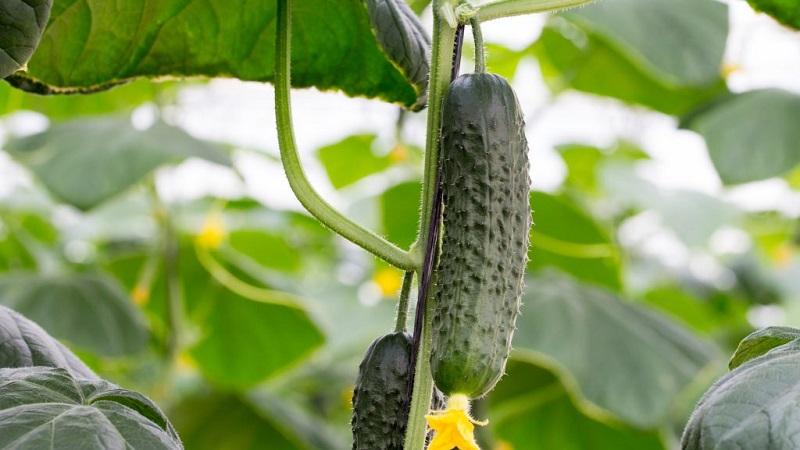
After the emergence of seedlings, the film is removed, the containers are brought out into the light. Water once a week. Seedlings grow strong and do not need feeding.
Seedlings are transferred to the ground at the end of May or at the beginning of June.... Planting scheme - 50x70 cm, 3 bushes per 1 m².
Pits 20-25 cm deep are dug on the site, spilled with a dark solution of potassium permanganate and seedlings are planted directly in peat glasses.
Care
Cucumbers are watered every other day, 10-15 liters per 1 m²using warm rainwater or settled water. In a drought, the bushes are sprinkled. The plants are irrigated so that the water evaporates from the leaf surface before nightfall.
If possible, drip irrigation is organized on the site. The beds are covered with mulch to retain moisture and reduce weeding.
The root system of cucumbers is superficial... For the formation of lashes and ovaries, the plant needs constant feeding with organic matter and minerals. Fertilizers applied before planting are enough for 2-3 weeks. Therefore, 10 days after planting the seedlings and from the moment the flowers appear after direct sowing, they begin to make the next portions of dressings, alternating organic matter and minerals.
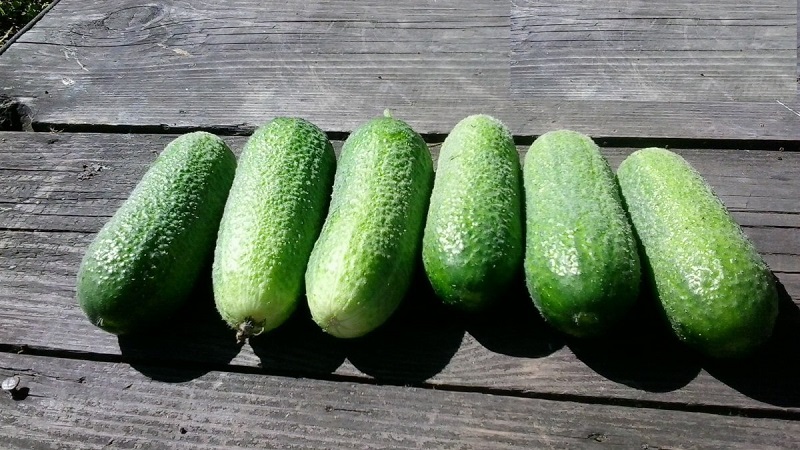
Top dressing options:
- green fertilizers (infusion of nettle or tops, diluted with water in a ratio of 1: 5);
- infusion of bird droppings at a concentration of 1:20;
- wood ash (200 g is poured into 10 liters of water, shaken and immediately watered under the bush);
- yeast (50 g of pressed yeast is poured into 3 liters of warm water, 50 g of sugar are added and fermentation is awaited);
- 10 g of superphosphate, 10 g of ammonium nitrate, 10 g of potassium salt per 10 liters of water;
- 30 g nitroammophoska per 10 liters of water;
- ready-made compositions: "Agricola", "Fertika", "BioHumus".
These formulations are suitable for root and foliar applications.... With yeast fertilizer, cucumbers are watered strictly under the bush in warm, dry weather.
Reference. The fertilizer consumption rate for young bushes is 500 ml, for adults - 1-2 liters. Seven days after feeding with ash, organic or nitrogen fertilizers are applied.
Features of cultivation and possible difficulties
Hybrid Adam grown on a dais so that the whips hang freely and do not lie on the ground... To do this, use:
- compost heaps: the top is leveled, earth is poured on top with a layer of 20 cm, humus is added and mixed;
- barrels: in the fall, containers are stuffed with tops, cut grass, leaves mixed with soil, and a layer of earth with fertilizers is poured on top.
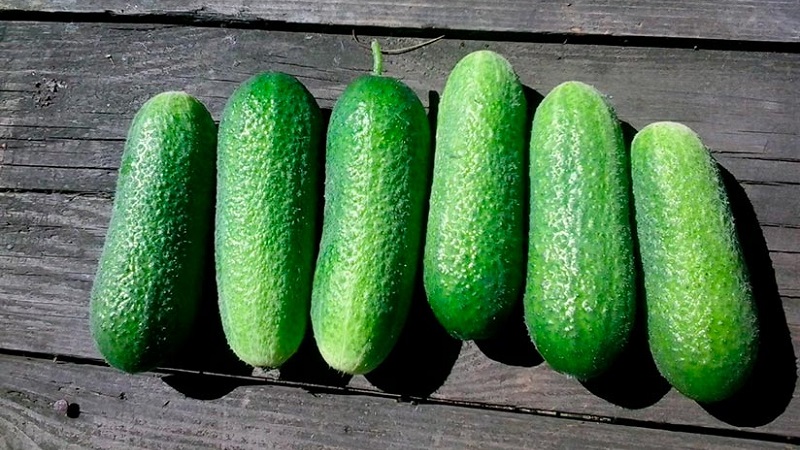
When planting on heaps, they adhere to the 60x15 cm scheme, and plant them in barrels denser - 4-5 bushes each.
Hybrid Adam, like any other parthenocarpic, needs to be molded with a garter to the trellis:
- in the axils of the first five leaves, shoots, flowers and ovaries are removed, which restrain the growth of the main stem;
- the main lash is tied up as it grows;
- stepchildren pinch over the second leaf to the height of the whip 0.5 m, over the third - up to 1 m, over the fourth - up to 1.5 m, over the fifth - up to 2 m;
- the lash is pinched or thrown over the bar as soon as it grows to the top of the trellis or to the ceiling of the greenhouse.
Diseases and pests
Hybrid Adam has immunity to olive spot, powdery mildew and cucumber mosaic virus... At the same time prone to disease peronosporosis or downy mildew.
It appears as yellow or brown spots on the leaves and purple-gray bloom on the back. Without treatment, the leaves turn yellow and the plant dies off. The early maturity of the hybrid complicates the fight against the fungus.
Harvesting is carried out from July to September, so fungicide treatment is excluded. The best way to maintain plantings is to prevent contamination.
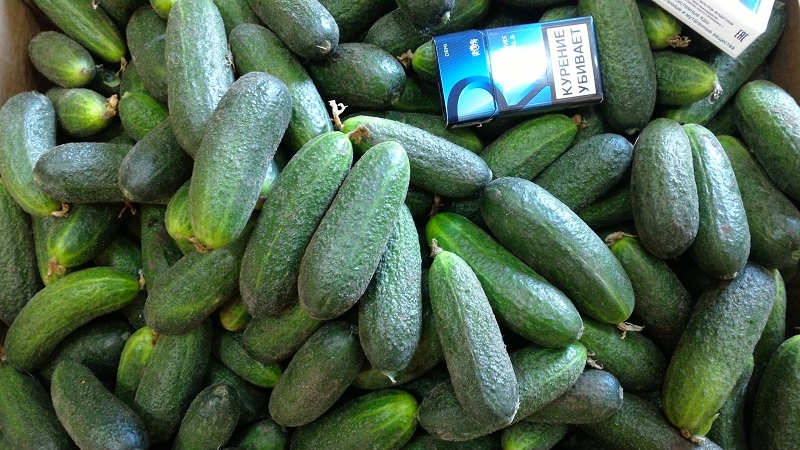
Prevention:
- spring soil disinfection with copper sulfate (50 g / 10 l / 1 m²) or "Fitosporin";
- regular loosening and cleaning of weeds;
- removal of affected bushes with rhizomes;
- compliance with crop rotation;
- processing with milk serum with iodine (10 drops per 1 liter);
- top dressing with vitamin compositions "Energen Extra", "Novosil".
Preventive spraying is carried out from the moment of flowering until the end of the season... Whey is used for processing once every 10 days, so as not to acidify the soil.
To fight with melon aphids, whitefly and spider mite use folk remedies:
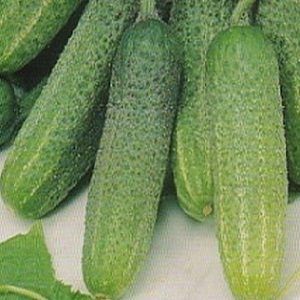 30 g of dry roots and foliage of dandelion is poured into 1 liter of water and insisted for three hours. Cucumbers are sprayed 2 times every 7 days.
30 g of dry roots and foliage of dandelion is poured into 1 liter of water and insisted for three hours. Cucumbers are sprayed 2 times every 7 days.- The hogweed root is poured with 10 liters of water. After 24 hours, use the infusion to treat bushes with a frequency of once every seven days.
- 100 g of dry raw dope ordinary pour 1 liter of warm water. After 12 hours, filter and process the bushes once every 10 days.
- A bucket of 10 liters is half filled with dry marigold inflorescences and filled with warm water. Insist for two days, filter and dissolve in the infusion 25 ml of liquid soap. The bushes are processed in the evening once every seven days.
Slugs are fought manually... They go hunting at night when the pest activates. To process the leaves, use a solution of ammonia (4 tablespoons per 2 liters of water), sprinkle the area with tobacco, mustard or hot pepper.
Cucumber plantings often attract a bear... To get rid of the insect, any vegetable oil is poured into the minks. It clogs the pest's airways. To scare away the bear, marigolds are planted in the beds, fish scales, eggshells, and needles are laid out.
Harvesting and application of the crop
The fruiting period of the hybrid is long... Harvesting begins in July and ends with the onset of frost.
Fruits are not prone to overgrowth... Greens not picked in time are slightly barreled, but this does not affect their taste.
Reference. A feature of cucumbers is a rough, prickly surface due to the large number of small tubercles. The fruits are used for fresh consumption and conservation.
Thin skin does not allow for long storage of the crop, dents often appear on the surface.
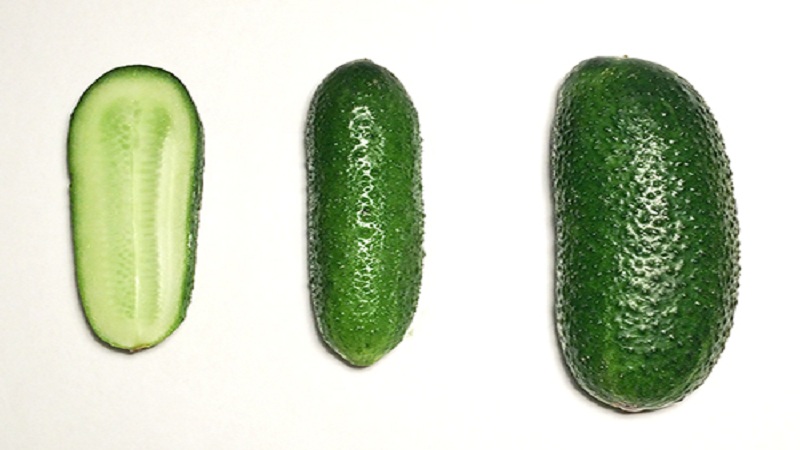
Advantages and disadvantages
Advantages of the hybrid Adam:
- high productivity;
- evenness of fruits;
- resistance to major diseases;
- early maturity;
- extended fruiting;
- the pulp is dense, not bitter;
- does not need pollinating insects;
- the fruits do not outgrow.
disadvantages - the need for molding and garters, a tendency to peronosporosis.
Reviews
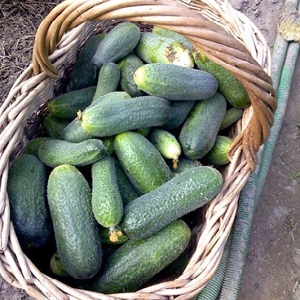 About hybrid Adam there are both positive and negative reviews.
About hybrid Adam there are both positive and negative reviews.
Ivan, Belgorod: “Adam will never plant cucumbers on my plot again. Zelentsy are prickly, dry, tasteless, and besides, they are barrel-shaped. On the plus side, cucumbers have no bitterness and voids, so they let the harvest for winter harvesting. ".
Oksana, Borisoglebsk: “I have been growing a wonderful hybrid Adam for three years in a row. It is easy to look after him. The culture pleases with high yield and excellent taste of fruits. The plant requires proper shaping, frequent watering and feeding.Otherwise, no worries with him ".
Makar, Kalach: “I plant cucumbers in 200 liter barrels. For a year now I have not been able to get the bear out on the site, but this method saves me from unnecessary work. I like the hybrid Adam for its ease of planting and care, long-term fruiting ".
Conclusion
Adam is an unpretentious hybrid suitable for cultivation in all regions of the country. Provides a rich harvest with minimal labor and material investment. The plant bears fruit until late autumn, allowing you to enjoy the taste of crispy cucumbers without bitterness.
Cultural agrotechnics include the formation of parthenocarpics, the timely introduction of organic matter and minerals, frequent watering and preventive treatments against downy mildew.